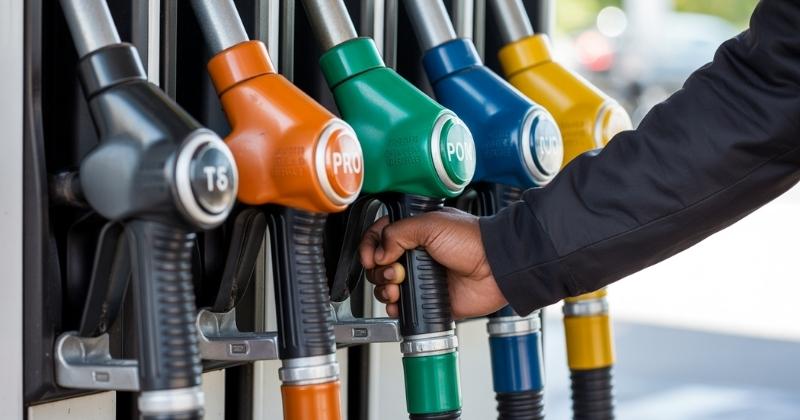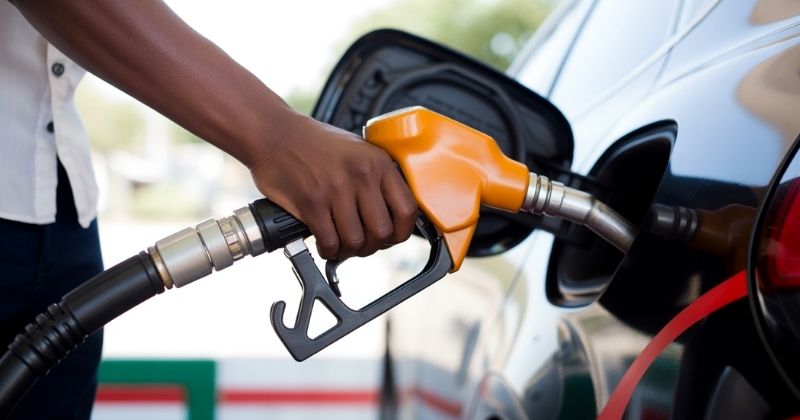
Mid-month calculations from the Central Energy Fund (CEF) indicate that motorists in South Africa are likely to see fuel price reductions across all grades in November, even though the rand has recently experienced a slight weakening. This marks a welcome relief for many households already stretched by rising grocery prices and electricity tariffs, especially as the festive season spending crunch approaches.
Key Takeaways
- Fuel prices set to drop in November: Petrol could decrease by up to 61 cents per litre and diesel by around 26 cents, offering much-needed relief for motorists and transport sectors heading into the festive season.
- Rand resilience supports recovery: Despite recent volatility, the rand’s relative stability, combined with weaker oil prices and stronger gold and platinum values, is helping drive fuel price reductions.
- Oil surplus drives global price decline: International Energy Agency forecasts of record oil oversupply and softer global demand are pushing crude prices down, improving South Africa’s prospects for continued fuel savings in the coming months.
About Arcadia Finance
Find the right loan faster with Arcadia Finance. Access 19 reliable, NCR-approved lenders at no cost and experience a smooth, worry-free process tailored to your goals.
Petrol and Diesel Prices Show Strong Recovery and Potential Savings for Motorists
At the beginning of October, petrol prices made a strong start, and over the last two weeks they have continued to improve steadily. Diesel prices have also maintained a solid upward trajectory in their over-recovery, showing consistent strength in global market alignment. Fleet owners and logistics companies, which rely heavily on diesel, could benefit substantially from this, helping to ease transport costs and potentially curb further food price inflation.
Petrol, in particular, is reflecting a notable over-recovery of between 58 and 61 cents per litre, suggesting that motorists could benefit from a fairly significant price cut. Diesel, meanwhile, is registering a more modest but still positive over-recovery of about 26 cents per litre. For the average motorist, a 60-cent cut could translate into savings of around R30 on a 50-litre tank, which, while modest, adds up significantly over time, especially for those commuting long distances.
Both the favourable rand to dollar exchange rate and movements in global petroleum product prices are currently contributing to this overall recovery pattern. This marks a clear contrast to the situation observed in September, when the oil market’s volatility undermined the rand’s relative strength, leading to less favourable outcomes.
Interestingly, South Africa’s fuel price system operates under the Basic Fuel Price (BFP) formula, which means even small global shifts in oil prices or currency exchange rates can ripple quickly through to the pumps.

Mid-Month Price Estimates
The CEF’s mid-month projections provide a useful snapshot of the current direction of fuel price trends:
| Fuel Type | Expected Change | Unit | Projection |
|---|---|---|---|
| Petrol 93 | -61 | cents per litre | Anticipated decrease |
| Petrol 95 | -58 | cents per litre | Anticipated decrease |
| Diesel 0.05% (wholesale) | -26 | cents per litre | Anticipated decrease |
| Diesel 0.005% (wholesale) | -26 | cents per litre | Anticipated decrease |
| Illuminating paraffin | -12 | cents per litre | Anticipated decrease |
The CEF does not provide daily figures for LP Gas, which makes it impossible at this stage to forecast a price change for the coming month. LP Gas is often the unsung hero of rural and low-income households, and any reduction here typically has an outsized impact on household budgets, especially during summer braai season.
While these daily indicators are not exact predictors of the official adjustment, they do offer a reliable indication of general market direction for the first half of the month. The Department of Petroleum and Mineral Resources will release the final official figures only a few days before implementation.
A handy tip for drivers: keep an eye on the final week of each month, as that’s when retailers start preparing for the adjustment. Sometimes filling up before midnight on the last Tuesday can save a few rand.
The Rand’s Recent Movements and Market Sentiment
The rand has displayed remarkable resilience in recent months, managing to maintain stability despite global uncertainties, including trade tensions and tariff disputes. While the rand might appear robust on the surface, economists point out that its overall performance against a broader basket of global currencies has been relatively flat. The rand often acts like a barometer for investor confidence in emerging markets. When global risk appetite fades, the local unit tends to wobble first.
The primary factor supporting the rand’s strength has been the weakening of the United States dollar. The greenback has depreciated by roughly 13% this year, giving the local currency some breathing room. However, the rand to dollar rate remains highly sensitive to developments in the American economy. As a rule of thumb, every 10-cent movement in the rand against the dollar can change the fuel price by roughly four cents per litre. Small on paper, but massive at scale.
During October, the rand performed particularly well, briefly approaching the R17.00/$ mark. This strength, however, was slightly reversed as the United States government shutdown unfolded and domestic data revealed pressure in several South African industries.
Nevertheless, as the month progressed, the rand regained some ground. This recovery was aided by indications from the US Federal Reserve suggesting forthcoming interest rate cuts, along with higher prices for commodities such as gold that support South Africa’s terms of trade. Gold and platinum, two of South Africa’s key exports, play a quiet but powerful role in strengthening the rand. When these metals rise, the country’s trade balance improves, often cushioning against global volatility.
Throughout this period, the rand has traded within a fairly broad range, dipping as low as R17.07/$ and climbing as high as R17.50/$. Analysts believe that if global conditions remain supportive, especially with gold and platinum maintaining upward momentum, the rand could strengthen further in the coming weeks, possibly testing the R17.00/$ level once again. A stronger rand does not just make imported oil cheaper; it can also help suppress inflation, giving the South African Reserve Bank more breathing room on interest rates in 2025.

Oil Price Developments and Their Impact
A crucial factor underpinning the latest round of fuel price recoveries has been the steady decline in international oil prices. Although prices have been moving within a narrow band, the general trend has been downward. Oil markets are often described as the world’s heartbeat. When prices fall, nearly every economy feels a pulse of relief, especially import-heavy nations like South Africa.
At the beginning of October, crude oil slipped below the 65-dollar per barrel threshold and has continued to fall, now trading at approximately 62.40 dollars. This decline has been largely driven by heightened trade tensions between China and the United States, which have dampened investor appetite for riskier assets. China, as the world’s largest crude importer, sets the tone for demand. When its manufacturing slows, global oil markets typically take a knock.
Adding to this is a forecast from the International Energy Agency predicting a record surplus in global crude supply. The agency now anticipates that oil production will exceed demand by nearly four million barrels per day in 2026, marking an 18% increase from its previous estimate. This revised outlook stems from growing production by OPEC+ members and stronger prospects among non-OPEC producers.
Several leading oil trading firms have also expressed the view that crude prices are likely to fall further in the near term. At the same time, signals from the US Federal Reserve have reinforced expectations of an upcoming rate cut in response to a cooling labour market, which has further pressured oil prices.
For South Africans, the connection is straightforward: lower global oil prices generally mean lower pump prices, provided the rand does not weaken too much in parallel.
Oil already recorded consecutive monthly losses in August and September. While the impact on South African pump prices during that period was mixed, the projections for November now indicate a more favourable scenario for motorists, with both petrol and diesel expected to decline.

Expected Retail and Wholesale Price Breakdown
The following tables summarise the anticipated adjustments for both inland and coastal regions, based on mid-month data (diesel prices shown are wholesale; retail pump prices will vary):
Inland Region
| Fuel Type | October Official | November Expected |
|---|---|---|
| 93 Petrol | R21.48 | R20.87 |
| 95 Petrol | R21.63 | R21.05 |
| Diesel 0.05% (wholesale) | R19.34 | R19.08 |
| Diesel 0.005% (wholesale) | R19.39 | R19.13 |
| Illuminating Paraffin | R12.99 | R12.87 |
Coastal Region
| Fuel Type | October Official | November Expected |
|---|---|---|
| 93 Petrol | R20.69 | R20.08 |
| 95 Petrol | R20.80 | R20.22 |
| Diesel 0.05% (wholesale) | R18.51 | R18.25 |
| Diesel 0.005% (wholesale) | R18.63 | R18.37 |
| Illuminating Paraffin | R11.98 | R11.86 |
Trivia for fuel-watchers: inland prices tend to be higher because of transport costs from coastal refineries, and the difference, around 80 cents to R1 per litre, has been consistent for over a decade.
Conclusion
South Africa’s fuel outlook for November appears promising, with both petrol and diesel showing notable over-recoveries driven by lower global oil prices, a stable rand, and improved commodity performance. These factors combine to offer potential relief for motorists, transport operators, and businesses that have been under pressure from persistent inflation. While fluctuations in the international oil market and exchange rate movements remain risks, the current trend signals a period of relative stability, providing consumers with some breathing room ahead of the busy holiday season.
Fast, uncomplicated, and trustworthy loan comparisons
At Arcadia Finance, you can compare loan offers from multiple lenders with no obligation and free of charge. Get a clear overview of your options and choose the best deal for you.
Fill out our form today to easily compare interest rates from 19 banks and find the right loan for you.


